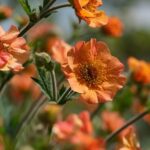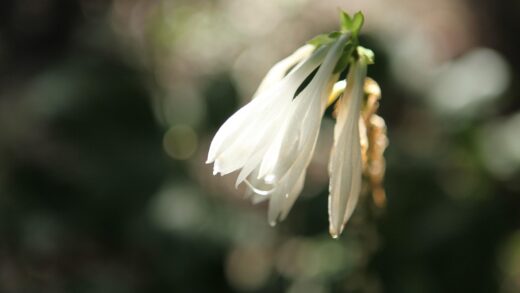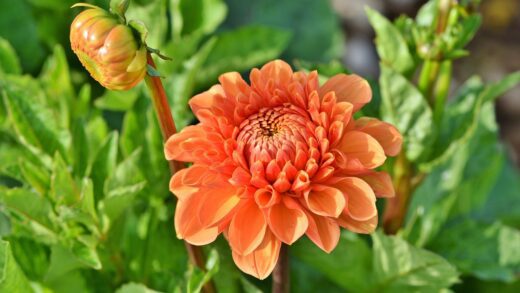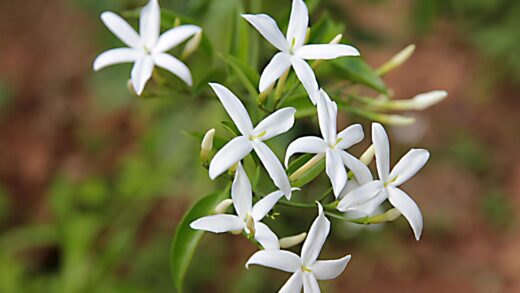While the Asiatic dayflower is known for its resilience and is generally a low-maintenance plant, it is not entirely immune to problems from diseases and pests. A proactive approach to plant health, which includes providing optimal growing conditions and regular monitoring, is the most effective way to prevent and manage these potential issues. Strong, healthy plants are inherently more resistant to attack than those that are stressed by poor conditions such as inadequate light, improper watering, or nutrient deficiencies. Familiarizing oneself with the common ailments that can affect this species allows for early detection and timely intervention, which can prevent minor problems from escalating into serious threats to the plant’s vitality.
The most common issues affecting the Asiatic dayflower are typically related to sap-sucking insects and fungal diseases, which are often encouraged by the moist, humid conditions that the plant itself prefers. Pests such as aphids can colonize the tender new growth, while slugs and snails may be drawn to the lush foliage. Fungal pathogens, particularly those that cause powdery mildew, can become problematic in situations where there is poor air circulation around the plants. Understanding the life cycles and preferences of these pests and pathogens is key to implementing effective and targeted control strategies.
Integrated Pest Management (IPM) offers a sensible and environmentally conscious framework for dealing with these challenges. IPM prioritizes non-chemical control methods first, such as cultural practices (e.g., proper spacing, correct watering), physical removal of pests, and the encouragement of natural predators. Chemical interventions are reserved as a last resort and are chosen to be as specific and minimally disruptive to the broader garden ecosystem as possible. This holistic approach ensures that the garden remains a healthy and balanced environment for all its inhabitants.
Regular inspection is the cornerstone of effective pest and disease management. Taking the time to closely examine the leaves (both upper and lower surfaces), stems, and flowers of the Asiatic dayflower at least once a week will enable the early identification of any tell-tale signs of trouble. Catching an aphid infestation when it is just a small cluster or noticing the first spots of powdery mildew allows for a much easier and more successful treatment than waiting until the problem has become widespread. This vigilance is the gardener’s most powerful tool in maintaining plant health.
Common insect pests
Several common insect pests may be attracted to the Asiatic dayflower, particularly its succulent leaves and stems. Aphids are perhaps the most frequent visitors. These are small, pear-shaped insects that can be green, black, or brown, and they typically congregate in clusters on the undersides of leaves and on new shoots. They feed by sucking the sap from the plant, which can cause the leaves to curl, yellow, and become distorted. In large numbers, they can weaken the plant and reduce its vigor, and they also excrete a sticky substance called honeydew, which can lead to the growth of sooty mold.
More articles on this topic
Spider mites are another potential pest, especially during hot, dry weather. These tiny arachnids are difficult to see with the naked eye, but their presence can be identified by the fine webbing they create on the plant and a stippled or speckled appearance on the leaves. Like aphids, they feed by sucking cell contents from the leaves, causing them to look bleached and unhealthy. A severe infestation can cause significant leaf drop and can severely stress the plant, making it more susceptible to other problems.
Management of these sap-sucking pests can often be achieved through simple, non-toxic methods. A strong spray of water from a garden hose can be effective at dislodging both aphids and spider mites from the plant. For more persistent infestations, insecticidal soap or horticultural oil, such as neem oil, can be applied. These products work by smothering the insects and are generally safe for beneficial insects when used correctly. It is important to ensure thorough coverage, especially on the undersides of the leaves where these pests tend to hide.
Encouraging natural predators is a highly effective long-term strategy for controlling pest populations. Ladybugs, lacewings, and hoverflies are all voracious predators of aphids, and their presence in the garden should be encouraged by planting a diversity of flowering plants that provide them with nectar and pollen. By fostering a healthy ecosystem, the garden can develop its own natural defense mechanisms, reducing the need for direct intervention and creating a more balanced and resilient environment for the Asiatic dayflower.
Snails and slugs
Snails and slugs are common garden pests that can cause considerable damage to the Asiatic dayflower, as they are particularly fond of its tender, moist foliage. These mollusks are most active at night or during damp, overcast weather, and their feeding activity results in irregularly shaped holes chewed in the leaves and sometimes on the flowers. A tell-tale sign of their presence, even if the culprits themselves are not visible, is the silvery slime trail they leave behind as they move across plant surfaces and the ground.
More articles on this topic
Effective management of slugs and snails involves a combination of strategies aimed at reducing their populations and protecting the plants. One of the simplest methods is hand-picking. By inspecting the garden in the evening with a flashlight, especially after rain, large numbers of these pests can be collected and removed. This method, while labor-intensive, can be surprisingly effective at reducing their numbers, particularly in a smaller garden setting.
Creating physical barriers around the plants can also deter slugs and snails. These pests have soft bodies and are reluctant to cross sharp or abrasive surfaces. A ring of crushed eggshells, coarse sand, or diatomaceous earth (a powder made from fossilized diatoms) placed around the base of the Asiatic dayflower can create an effective barrier. Copper tape or wire is another option; when slugs or snails come into contact with copper, they receive a small electric shock, which repels them.
There are also several types of baits that can be used to control slug and snail populations. Traditional slug pellets often contain metaldehyde, which is effective but can be harmful to pets and wildlife. A safer alternative is to use baits that contain iron phosphate as the active ingredient. Iron phosphate is toxic to slugs and snails but is safe for other animals and breaks down into fertilizer for the soil. Beer traps, which are shallow containers of beer sunk into the ground, are another classic method; the pests are attracted to the yeast, fall in, and drown.
Fungal diseases
The Asiatic dayflower’s preference for moist conditions can sometimes make it susceptible to fungal diseases, with powdery mildew being the most common. This disease is easily identified by the characteristic white or grayish, powdery patches that appear on the surfaces of leaves, stems, and sometimes flowers. While it rarely kills the plant, a severe infection can interfere with photosynthesis, reduce the plant’s vigor, and cause leaves to yellow and drop prematurely, detracting from its ornamental value.
Powdery mildew thrives in conditions of high humidity combined with poor air circulation. It is often most prevalent in late summer when warm days are followed by cool, damp nights. To prevent its occurrence, cultural practices are key. Ensure that plants are not overcrowded by providing adequate spacing between them to promote good airflow. When watering, apply water directly to the soil at the base of the plant to keep the foliage as dry as possible, as wet leaves create an ideal environment for fungal spores to germinate.
If powdery mildew does appear, it is important to act quickly to prevent it from spreading. For a mild infection, simply pruning off and disposing of the affected leaves can be enough to control the problem. It is important to destroy the infected material and not add it to a compost pile, as the fungal spores can survive and spread. For more widespread infections, there are several effective fungicidal sprays that can be used.
Both commercial and homemade remedies are available for treating powdery mildew. Horticultural oils, such as neem oil, and sulfur-based fungicides are effective commercial options. A simple and effective homemade spray can be made by mixing one tablespoon of baking soda and half a teaspoon of liquid soap in four liters of water. This solution works by changing the pH of the leaf surface, making it inhospitable to the fungus. Whichever spray is used, it should be applied thoroughly to all affected parts of the plant, and repeated applications may be necessary.
Prevention strategies
The most effective approach to managing pests and diseases on the Asiatic dayflower is through prevention rather than cure. Creating a healthy growing environment is the first and most important line of defense. This starts with proper site selection, choosing a location with the appropriate amount of light and well-draining soil. Amending the soil with plenty of organic matter will not only provide essential nutrients but also improve soil structure and support a healthy population of beneficial microorganisms that can help to suppress soil-borne pathogens.
Cultural practices play a vital role in preventing problems from taking hold. Proper spacing between plants is crucial for ensuring good air circulation, which is one of the most effective ways to prevent the development of fungal diseases like powdery mildew. A consistent and appropriate watering regime, which keeps the soil moist but not waterlogged and keeps the foliage dry, will reduce stress on the plant and make it less susceptible to both pests and diseases.
Maintaining good garden hygiene is another key preventative measure. Regularly removing any dead or diseased leaves and stems from the plant can prevent the spread of pathogens. At the end of the growing season, it is important to clear away all plant debris, as this can harbor overwintering pest eggs or fungal spores that could cause problems in the following year. Keeping the area around the plants free of weeds is also beneficial, as weeds can compete for resources and act as hosts for various pests and diseases.
Finally, promoting biodiversity in the garden is a powerful long-term strategy for pest prevention. By planting a wide variety of plants, especially native species that provide nectar and pollen, you can attract and support a healthy population of beneficial insects, such as ladybugs, lacewings, and parasitic wasps. These natural predators are incredibly effective at keeping pest populations in check, creating a self-regulating ecosystem that requires minimal intervention. A diverse and healthy garden is a resilient garden.


















